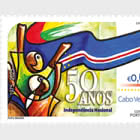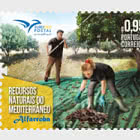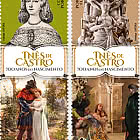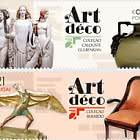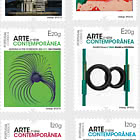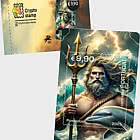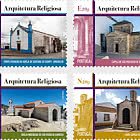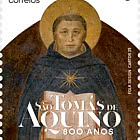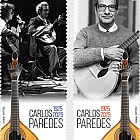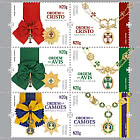Portuguese Numismatics - 2nd Group
In 2021, in partnership with the INCM, CTT continues its Portuguese Numismatics series by presenting five coins minted in Portugal between the 12th and 16th centuries. These are some of the greatest numismatic treasures in the country, bearing witness to episodes spanning centuries of history. They offer a paradigmatic portrayal of the big issues marking our past: the legitimising of independence, the founding of the country, the consolidation of royal authority, the development of national symbols and the start of the discoveries and overseas expansion.
Mário de Gouveia
Portuguese Mint and Official Printing Office Portuguese Mint Museum
The dinheiro (INCM/MCM 4234) was minted under King Afonso I. It shows a pentagram with a dot in the centre, with the letters ALFONSVS (‘Afonso’); and a cross flanked by the letters REX POR (‘King of Portugal’). The first Portuguese coin, the dinheiro marks a period when the kingdom won its independence and the king sought to consolidate his political legitimacy.
The morabitino (INCM/MCM 4235) was minted under King Sancho I. It shows the coat of arms of the kingdom, formed of escutcheons in a cross formation with bezants arranged in a saltire, surrounded by stars, with the letters + IN NE PTRIS FILII SPS SCI A (‘+ In the name of the Father, the Son and the Holy Ghost, Amen’); and the image of the king on horseback, holding a sword in his right hand and a sceptre with cross in the left, with the lettering SANCIVS REX PORTVGALIS (‘Sancho, king of Portugal’). The first gold coin, the morabitino depicts the king fighting the Muslims and expanding the frontiers of Christianity.
The tornês (INCM/MCM 4263) was minted under King Dinis. It shows the coat of arms of the kingdom, formed of escutcheons in a cross formation with bezants arranged in a saltire, with the letters + DIONISII REGIS PORTUGALIE ET ALGARBI (‘[Coin] of Dinis, King of Portugal and the Algarves’); and a cross inscribed in a circle, with the letters
+ ADIUTORIUM NOSTRUM IN NOMINE DOMN / QUI FECIT CELUM ET
TERRAM (‘Our aid [is] in the name of the Lord, who made heaven and earth’). The first silver coin, the tornês marks a period in which the king sought to consolidate his authority in a climate of internal dispute.
The justo (INCM/MCM 4881) was minted under King João II. It shows the coat of arms of the kingdom, formed of a crowned shield containing escutcheons in a cross formation, with bezants arranged in a saltire, and a bordure of castles, with the letters + IOHA ES 2 R PORTVGALIE ALGR D S GVINEE (‘João II, King of Portugal and the Algarves, Lord of Guinea’); and the image of the king on the throne, a crown on his head, a cloak around his body and a sword in his right hand, with the lettering
+ IVSTVS VT PALMA FLOREBIT (‘The just will flourish like the palm’). The justo is the coin that marks the overseas expansion and the Portuguese presence on the trading routes for African gold and slaves.
The português (INCM/MCM 4906) was minted under King Manuel I. It shows the coat of arms of the kingdom, formed of a crowned shield containing escutcheons in a cross formation, with bezants arranged in a saltire and a bordure of castles, with the letters + I EMA VEL R PORTVGALIE AL C VL I A D G / C C ETHIOPIE ARABIE PERSIE I
(‘Manuel I, King of Portugal and the Algarves, here and overseas in Africa, Lord of Guinea, of trade, navigation and conquest of Ethiopia, Arabia, Persia and India’); and the cross of the Order of Christ, with the lettering + I HOC SIG O VI CEES (‘In this sign thou shalt conquer’). The português is a coin of international prestige, symbolising an empire whose power spread through the trade of products from the East.
Portugal - Recommended stamp issues
WOPA+ recommended stamp issues
| Avatar - Fire and Ash |
| Issued: 03.12.2025 |
| ›New Zealand |
| 50th Anniversary of the Founding of the 24th November Bar Scout |
| Issued: 24.11.2025 |
| ›Montenegro |
| Krisjanis Valdemars |
| Issued: 02.12.2025 |
| ›Latvia |
| Sign Language - Good |
| Issued: 02.12.2025 |
| ›Bosnia and Herzegovina - Republic of Srpska |
| In Memory of the Fallen and Murdered on October 7, 2023 |
| Issued: 08.10.2025 |
| ›Israel |
| Annual Collection Folder (New York) |
| Issued: 05.12.2025 |
| ›United Nations |
| Year Set |
| Issued: 24.11.2025 |
| ›Isle of Man |
| Shipping in the 17th and 18th Centuries - Peat Shipping |
| Issued: 05.12.2025 |
| ›Netherlands |





